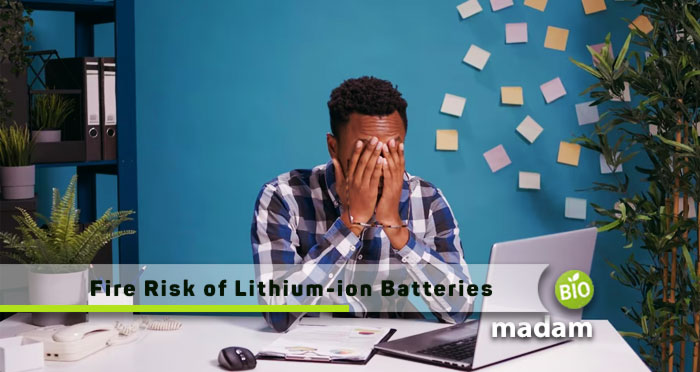With the increased use of technology, lithium-ion batteries have become one of the go-to products for powering all types of devices. But while there are many advantages to using these batteries, such as their high capacity and performance capabilities, they also come with an inherent fire risk that needs to be managed. This makes understanding and properly managing your lithium-ion battery use—especially if storing them in bulk—crucial for both safety and compliance purposes. In this post, we’ll dig into why you should take extra precautions when it comes to fire hazards associated with lithium-ion batteries, plus tips on how to safely manage storage and any potential risks arising from their use.
What You Should Know About the Risks of Fire from Lithium-Ion Batteries
Lithium-ion batteries are commonly used in devices such as smartphones, laptops, and electric cars because of their high energy density and long lifespan. However, with such benefits come certain risks. One of the biggest risks associated with lithium-ion batteries is the possibility of fire. If the battery is damaged or defective, excessive heat can build up, leading to a thermal runaway reaction that can cause the battery to explode or catch fire. The consequences of such an incident can be devastating, both in terms of personal injury and property damage. It is therefore important to take precautions such as only using chargers designed for the specific device, avoiding severe impacts or punctures to batteries, and storing them in cool and dry areas. Being aware of the risks and taking preventive measures can help ensure the safe use of lithium-ion batteries.
The Different Types of Lithium-Ion Batteries and Their Fire Risk Levels
Lithium-ion batteries are one of the most commonly used types of batteries in everyday items like smartphones and laptops. However, not all lithium-ion batteries are created equal, and their fire risk levels vary depending on their composition. There are three primary types of lithium-ion batteries: nickel-cobalt-aluminum (NCA), nickel-cobalt-manganese (NCM), and lithium-iron-phosphate (LFP). NCA batteries have the highest energy density, but their fire risk is also the highest. NCM batteries have a medium energy density and a moderate fire risk. LFP batteries have the lowest energy density but are also the safest, with a low fire risk. It’s important to be aware of the differences between these battery types and understand the appropriate precautions to take to prevent a potential battery fire.

Steps you can take to Mitigate Fire Risk from Lithium-Ion Batteries
Lithium-ion batteries are widely used in various electronic devices and have become an integral part of our daily lives. However, they have also been known to cause fires if not handled properly. This is how you can lower this risk:
- It’s crucial to avoid overcharging your lithium-ion batteries as this can cause overheating and eventually result in a fire.
- Ensure that you’re using the correct charger for your device, as using the wrong charger can lead to overheating and cause the battery to explode.
- It’s essential to store and transport your lithium-ion batteries in the correct manner to avoid any damage to the battery pack.
By following these simple steps, you can significantly reduce the risk of a fire caused by lithium-ion batteries.
Hire Fire Protection Services
Although lithium-ion batteries have become increasingly popular due to their high energy density and longer lifespan, they also pose a potential fire risk if not handled and stored properly. To ensure the safety of your property and personnel, it’s crucial to be prepared for the fire risk associated with lithium-ion batteries. One effective measure is to hire fire protection services that specialize in mitigating such risks. Look into Australian Fire Protection services if you live in the area to ensure you are prepared for fire risk. By taking this proactive step, you can minimize the chances of a battery-related fire and protect your assets.
How to Properly Store and Dispose of Lithium-Ion Batteries
It’s essential to keep lithium-ion batteries away from combustible material and to store them in a cool, dry place. When it comes time to dispose of them, you should never throw them in the trash or recycle bin. Instead, take them to a designated battery recycling facility. These facilities will ensure that the batteries are properly handled and that any toxic chemicals they contain are disposed of safely. By following these guidelines, you can help prevent fires, protect the environment, and keep yourself safe.
Regulations that Could Help Decrease Fire Risk from Lithium Ion Batteries
Various incidents in recent years have highlighted the dangers of these batteries, whether it’s automotive or personal electronics. To prevent accidents, regulations have been put forward to standardize the manufacturing process of these batteries. These regulations involve improving safety standards and enhancing transport guidelines. With the correct safeguards in place, risks can be limited. Ultimately, these regulations could help to make these powerful batteries safer to use, giving consumers greater peace of mind.
Signs to Look for that a Battery May be at Risk of Catching on Fire
Almost all of our electronic devices, from phones to laptops, run on a rechargeable battery. While these batteries are generally safe, there are certain things you should look out for to ensure they don’t become a hazard. Some of the signs to look for that a battery may be at risk of catching on fire include excessive heat, swelling or bulging, leaks or spills, and a noticeable change in performance or longevity. By being vigilant and taking note of any of these warning signs, you can protect yourself and your devices from potential damage or harm.

To sum up, when it comes to the risks of fire from lithium-ion batteries, there are a few essential points to keep in mind. First, there are several types of lithium-ion batteries on the market today and each has a different level of fire risk associated with them. Taking some basic steps to ensure that your battery is properly handled and stored can help mitigate these risks. Additionally, understanding what to look for (such as swelling or overheating) can alert you to potential danger from faulty batteries. Finally, while regulations are already in place on a federal level, there is still room for improvement by states and other countries to create even more stringent laws around shipping standards and disposal regulations. Remembering these tips can help make sure your lithium-ion battery usage stays safe!

Hi, they call me Jenna, and I am also known for achieving a gold medal during my Ph.D. in science life. I always had a dream to educate people through my utmost writing hobby. So, I chose this blogging path, and Biomadam gave me this opportunity to present for them. I now stand to entertain you. Continue reading my articles & discuss if you’ve any confusion through the comment section below.

